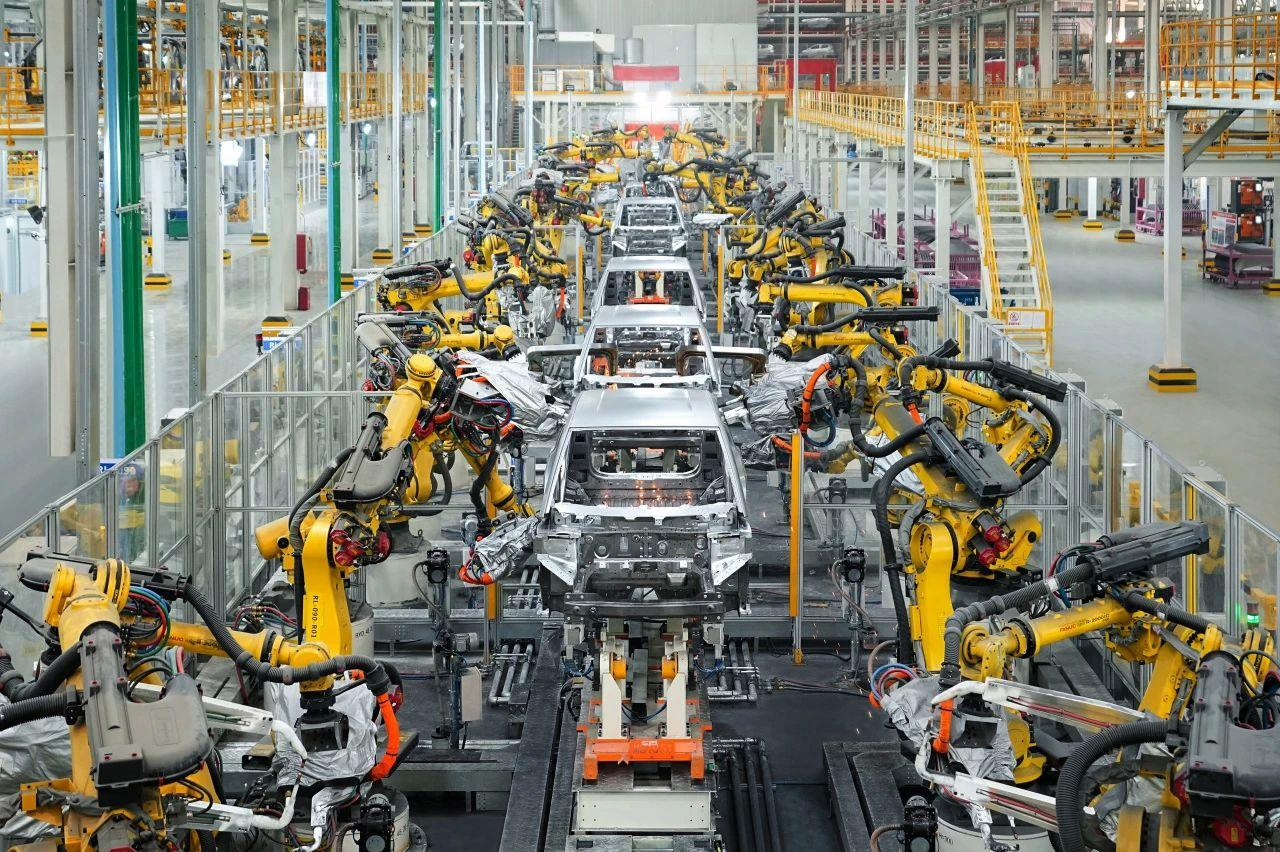The Republic of Türkiye
1. Introduction
Republic of Türkiye (referred to as Türkiye for short) is a country spanning Asia and Europe, bordering the Black Sea to the north, the Mediterranean Sea to the south, Syria and Iraq to the southeast, the Aegean Sea to the west, Greece and Bulgaria to the east, and Georgia, Armenia, Azerbaijan and Iran to the east. Türkiye's geographical location and geopolitical strategic significance are extremely important, and it is a crossroad connecting Europe and Asia. Ankara, the capital, and Istanbul are the largest City.
Türkiye is a candidate of the European Union, which spans Asia and Europe and implements the European model in political, economic, cultural and other fields. Türkiye is a member of NATO, a founding member of the Organization for Economic Cooperation and Development and a member of the G20. Having a strong industrial foundation, it is one of the emerging economies in the world and one of the fastest-growing countries in the world.
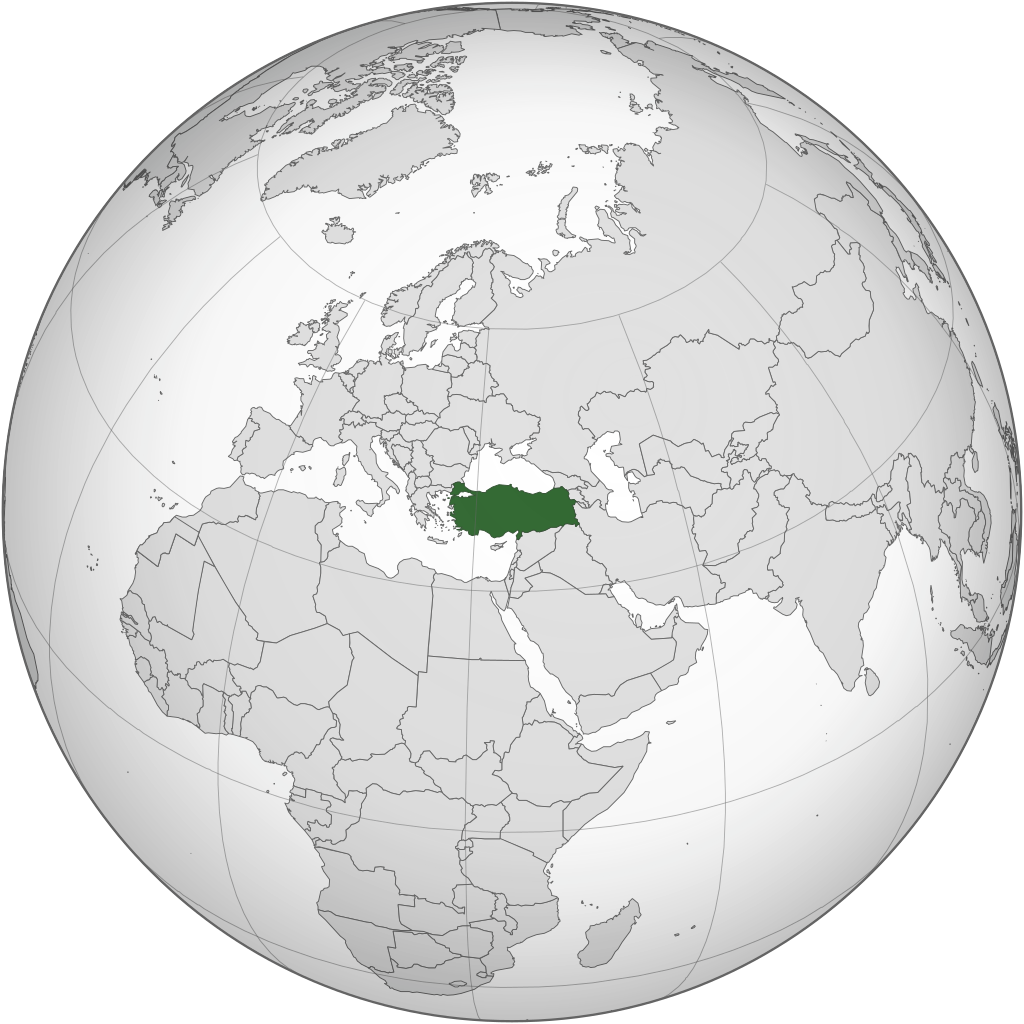
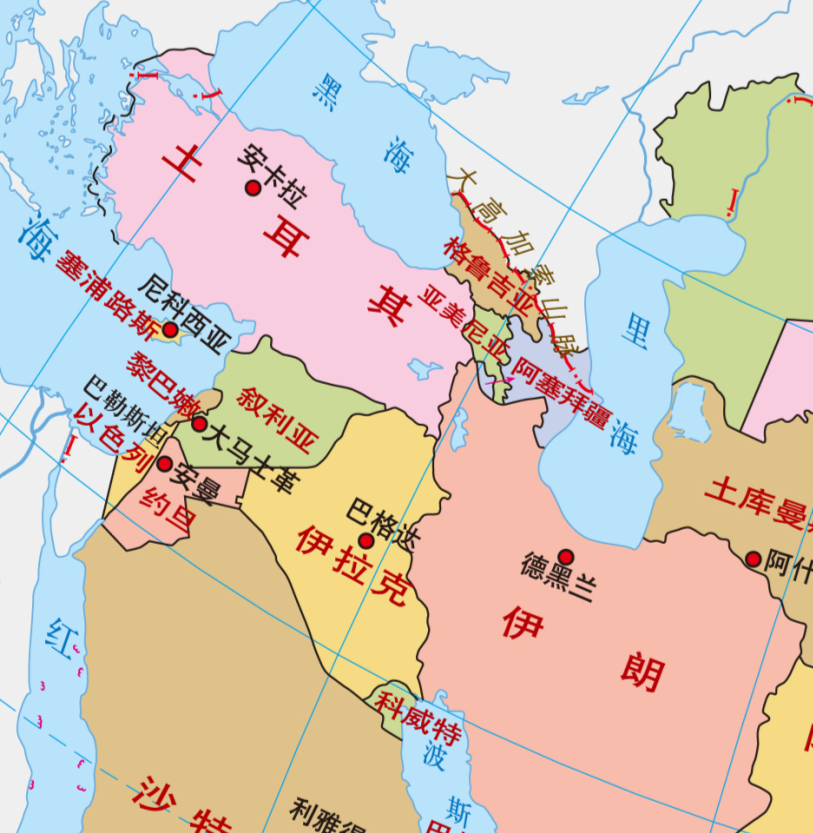
2. History
Ancient times:?
Classical era: 19th century BC to 1st century BC
Roman and Byzantine periods: 1st century BC to 1071
Seljuk Empire: 1037-1194
Sultanate of Roma: 1077-1308
Ottoman Marquis: 1299-1308
Ottoman Empire: 1299-1922
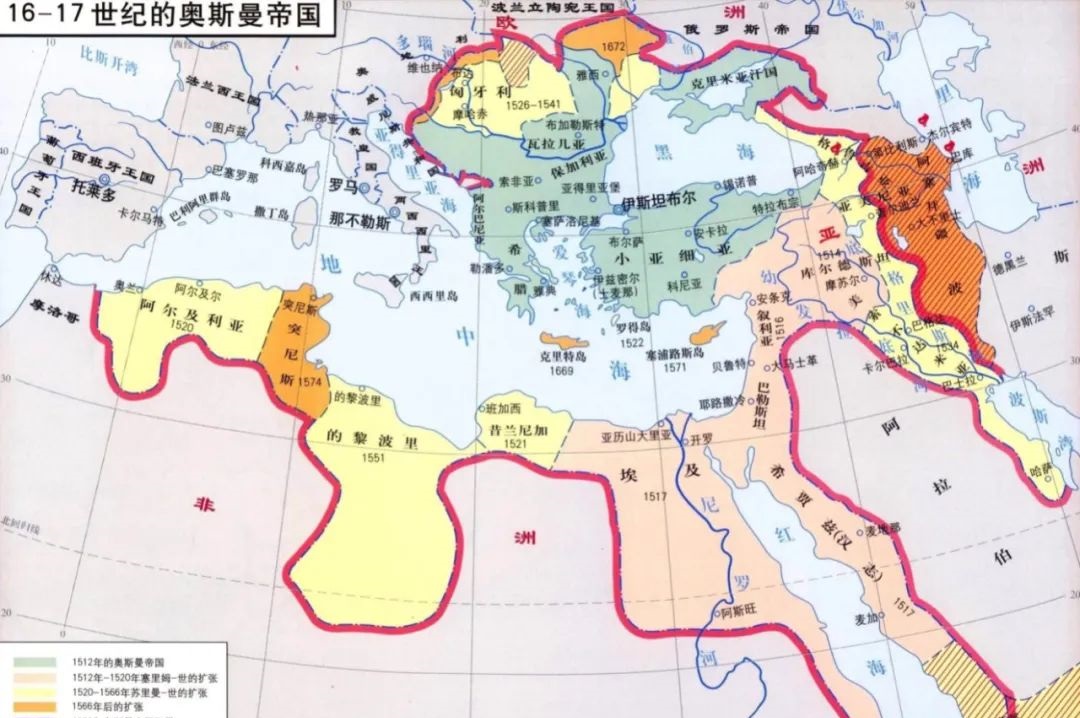
Republic of Türkiye: 1923- present
3. Province
Türkiye is divided into 81 provinces.
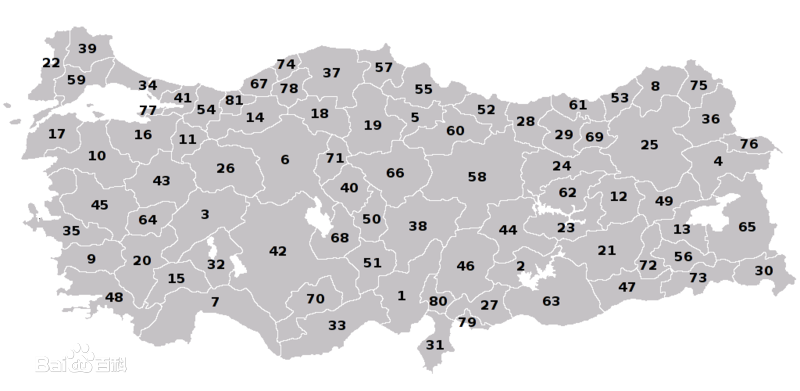
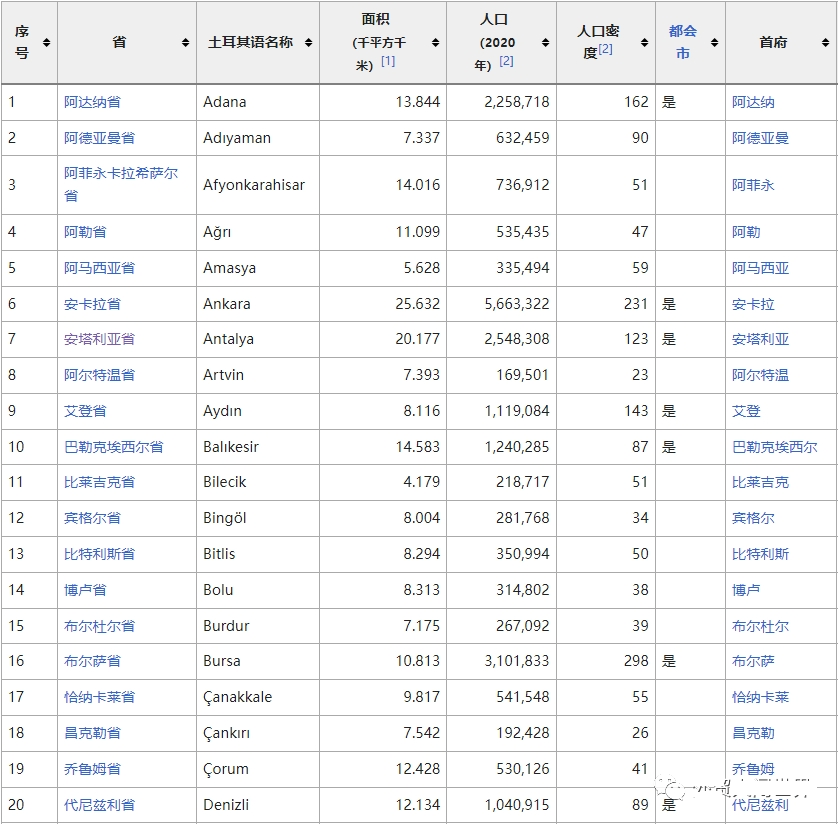
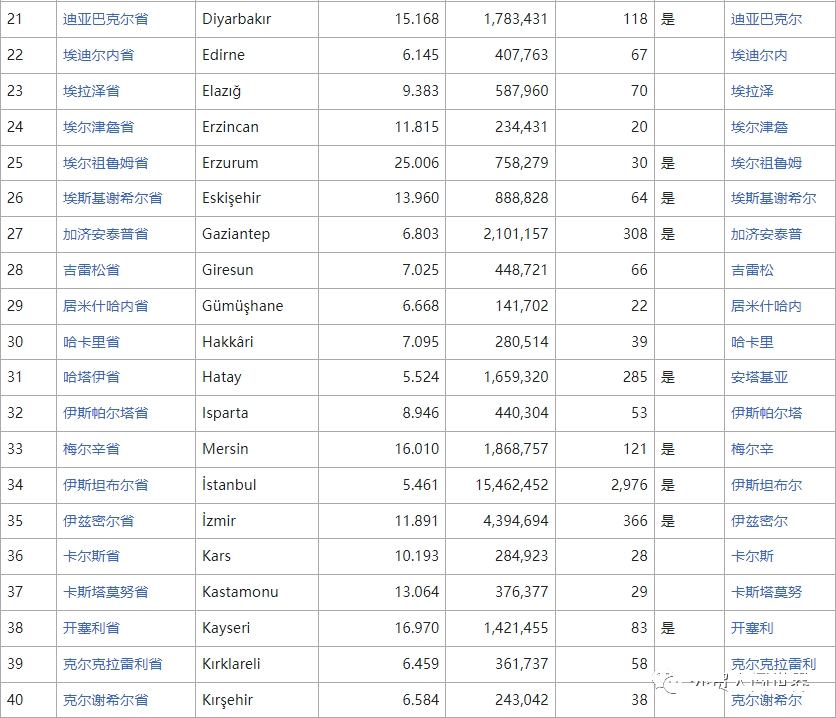

The geographical division of Türkiye has seven regions, which were first defined in the first Türkiye Geographical Congress held in Ankara from June 6 to June 21, 1941. Geographical division is not used for administrative division, but for land administration, household administration, education and other purposes. Its division is also irrelevant to Türkiye's provinces. Seven sub regions are: Mediterranean region, Eastern Anatolia region, Aegean Sea region, Southeast Anatolia region, Central Anatolia region, Black Sea region, and Mamora region.
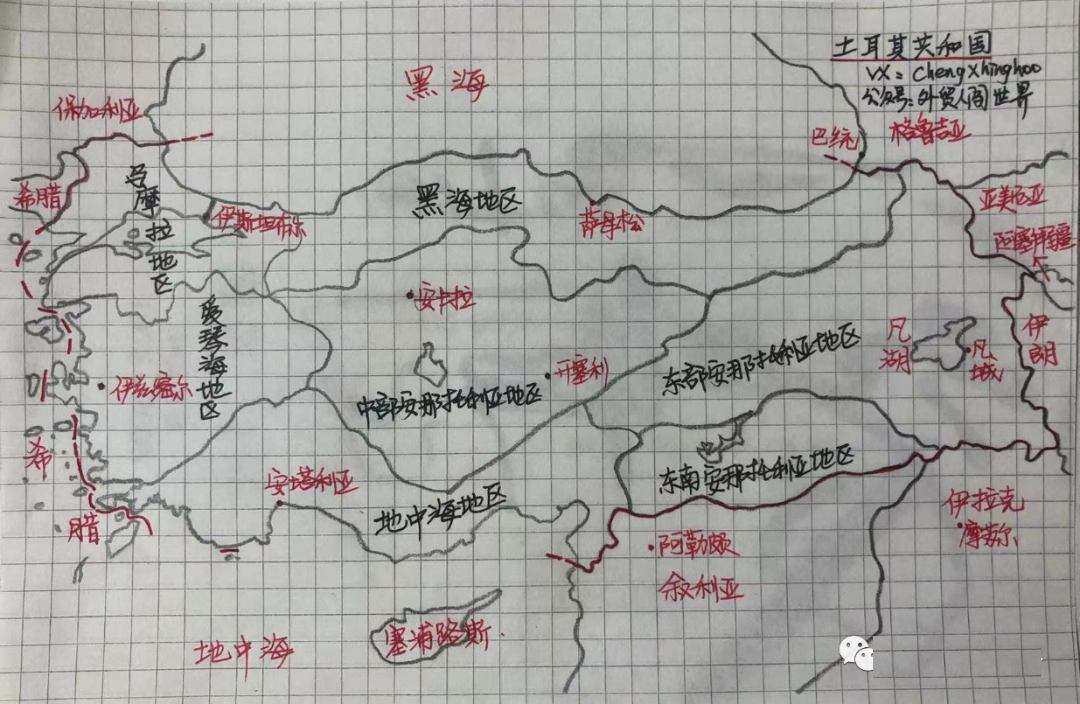
4. City
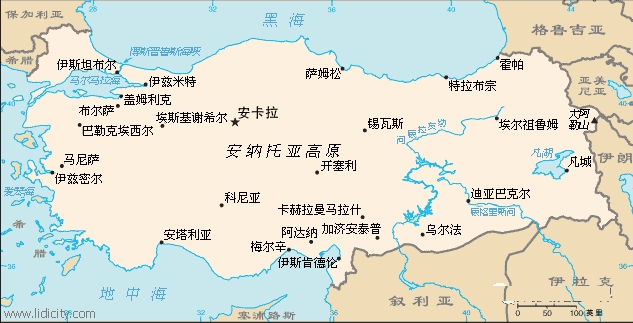
Istanbul
Formerly known as Constantinople, it is the economic, cultural and transportation center of Türkiye, a world famous tourist resort, and one of the prosperous international metropolises. Located at the eastern end of the Balkan Peninsula, on the west bank of the southern mouth of the Bosporus Strait, and at the entrance of the Black Sea, it is a crucial transportation hub for Europe and Asia, with an extremely important strategic position. The urban area has expanded to the north of the Golden Horn, and the eastern coast of the Bosphorus Strait, also included in the urban area, becoming a modern city spanning Europe and Asia.
Ankara
The capital and the second largest city of Türkiye, the capital of Ankara Province, is located in the northwest of Anatolian Plateau on the Peninsula of Asia Minor. As the political, economic, cultural, transportation and trade center of Türkiye, Ankara is the second largest industrial center in the country after Istanbul. There are east-west railway trunk lines leading to major cities and ports in the country, and several roads leading to all parties. The airport maintains domestic and international air connections. It has been a traffic fortress since ancient times, known as the "heart of Türkiye". Ankara is an ancient city with a long history, and people can trace its history back to ancient times. There are many scenic spots and historical sites in the city of Ankara, such as the Julian pillars of the Roman era and the Temple of Augustus; Castles and cemeteries during the Byzantine period; The Aladdin Mosque during the Seljuk period, as well as the Muhammad Pasha Market and Muhammad Market during the Ottoman period. Ankara is also a modern metropolis, with a stream of cars on the streets and towering buildings along the roads.
Izmir
The third largest city in Türkiye, located on the Aegean Sea at the western end of the Anatolian Plateau, is one of the important industrial, commercial, foreign trade and shipping centers, as well as a historic and cultural city, tourist resort and military fortress. Since ancient times, the city has been the center of the agricultural zone along the Aegean Sea, with a clean and tidy urban area of Izmir, surrounded by tall buildings. Izmir also preserves numerous scenic spots and historical sites, such as the ancient bell tower, the 15th century Hisar Mosque, and the remains of the Artemi Temple, one of the seven wonders of ancient times in the world. Worldrenowned include the ruins of the ancient Greek city of Ephesus, the last resting place of the Virgin Mary, and so on. The green mountains and clear water set off the broad seaside avenue under palm trees, and the Aegean Sea rippled with ripples, beating against the long seawall. Fish such as phoenix tails and silver arrows frequently jumped out of the water, and groups of seagulls flew among the waves, connecting the water and sky, creating an incredibly beautiful scenery.
5. Transportation
highway
The roads in Türkiye are in good condition and are the main land transportation mode. The total length of highways is 69000 kilometers, including 3523 kilometers of highways, 31000 kilometers of national highways, and 34000 kilometers of provincial highways.
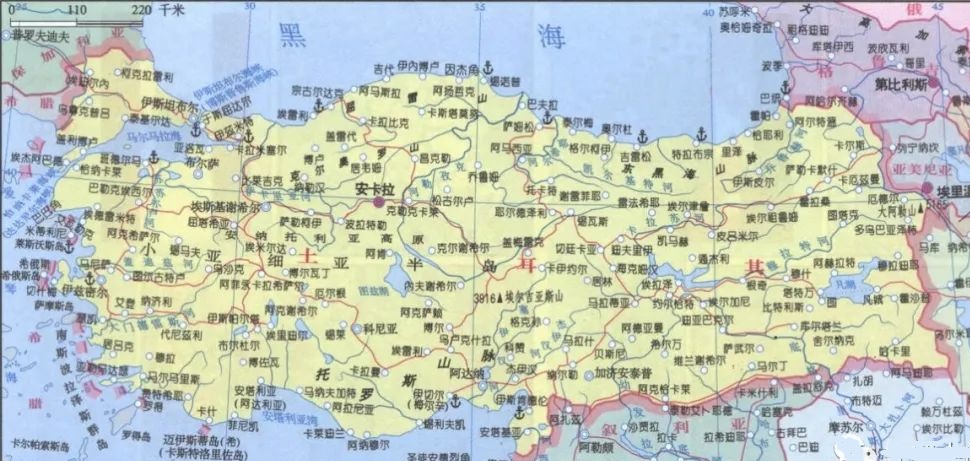
railway
The total length of railways in Türkiye is 13000 kilometers, including 1213 kilometers of high-speed railways.
The first high-speed railway in Türkiye: Ankara Istanbul High speed Railway Phase I (Ankara Eskisher) was opened on March 13, 2009, and the second high-speed railway: Ankara Konya High speed Railway was opened on August 23, 2011.
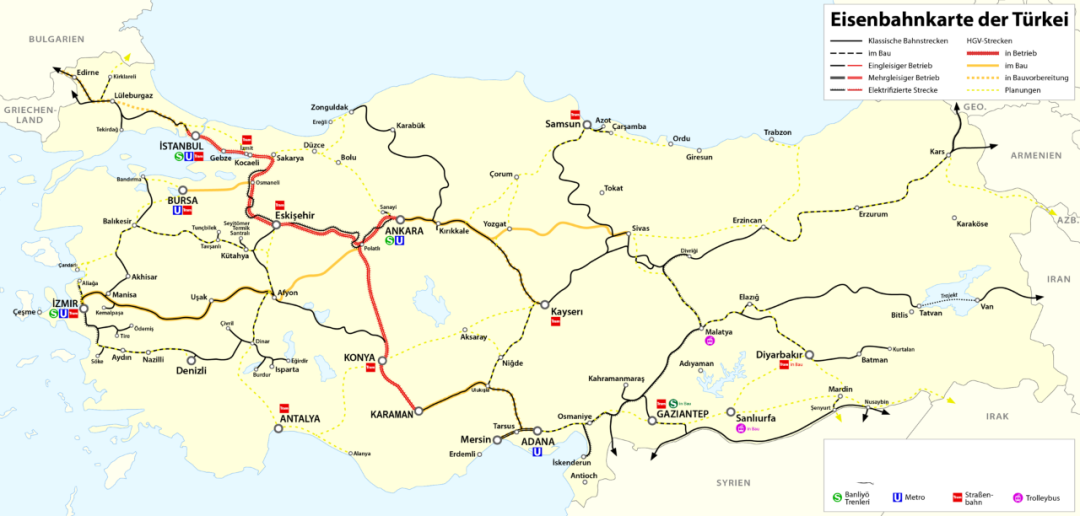
shipping
Türkiye is surrounded by the sea in the north, west and south, namely, the Black Sea, the Marmara Sea, the Aegean Sea and the Mediterranean Sea, as well as the Dardanelles Strait and the Bosporus Strait, with a coastline of 7200 kilometers, which gives it a competitive advantage in maritime transportation.
Istanbul, Izmir, Mersin and Samson are the main seaports in Türkiye.
Major airports
Istanbul Airport, Ankara Esenboga International Airport.
Subway system
Cities such as Istanbul and Ankara have subways.
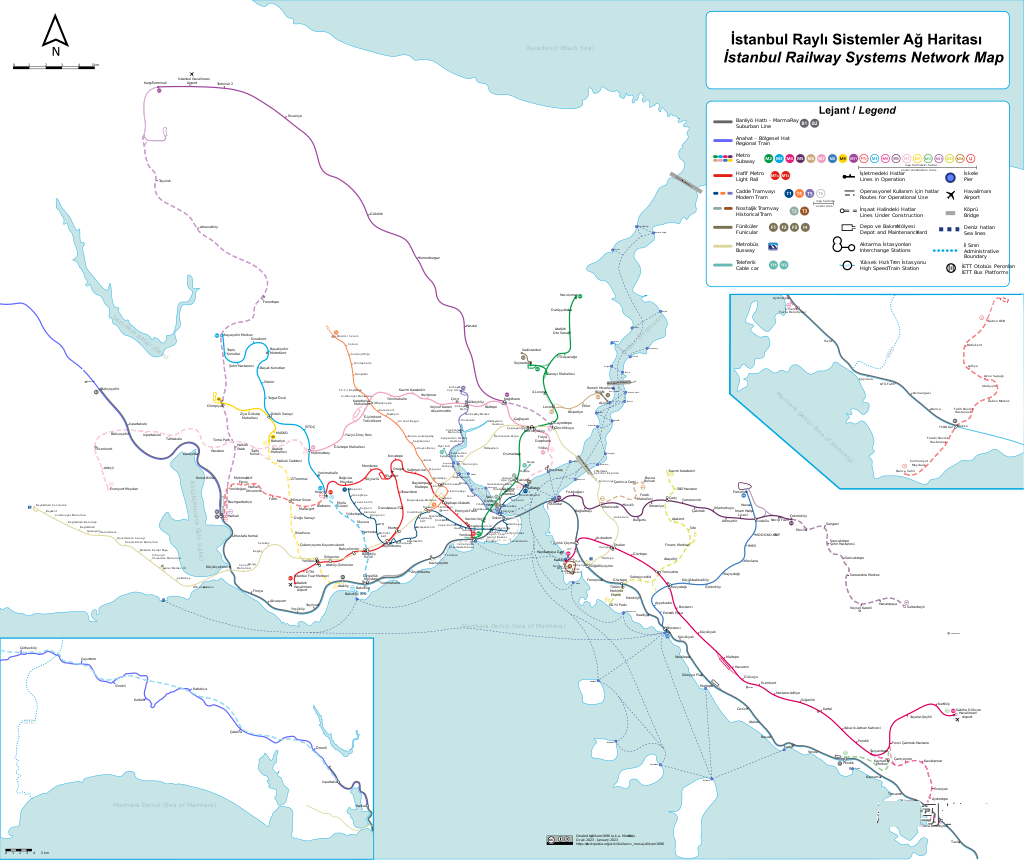
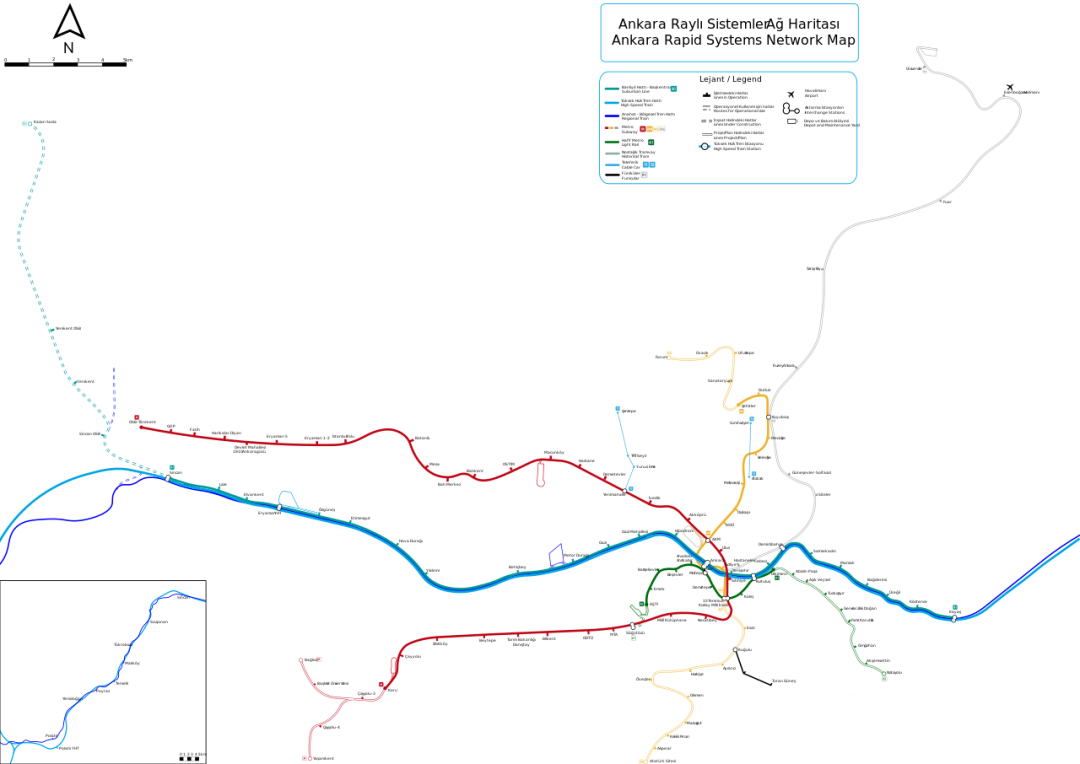
6. Economy
summary
Since the implementation of the opening-up policy in the 1980s, the local economy has achieved leapfrog development. In the 1990s, Türkiye's economy developed rapidly. Türkiye is a leader in the production of agricultural products, textiles, automobiles, ships and other means of transport, building materials and household electronics. In recent years, Türkiye has developed significantly in the private sector, but state-owned enterprises still play an important role in industry, banking, transportation and communication.
natural resources
In terms of mineral diversity, Türkiye ranks 10th in the world, with about 60 kinds of minerals currently produced, of which boron salt reserves are the most abundant, and Türkiye's reserves account for 72% of the world's total. There are also coal, iron, copper, chromium, uranium, antimony, mercury, gold, barite, borate, strontium, gold steel sand, feldspar, limestone, magnesite, marble, perlite, pumice, pyrite, and clay.
agriculture
The agricultural foundation is good, and the main agricultural products include tobacco, cotton, rice, olives, sugar beets, tangerines, livestock, etc. The main agricultural and sideline products such as grain, cotton, fruits, vegetables, and meat have basically achieved self-sufficiency, with a self-sufficiency rate of 98.8% for grain. In terms of agricultural land, it is one of the largest countries in the world and one of the few countries in the world that can be self-sufficient without relying on imports, with surplus agricultural products available for export.
industry
The industrial foundation is good, mainly including food processing, textiles, automobiles, shipbuilding, mining, steel, petroleum, construction, wood, and paper industries.
Tourism industry
Türkiye is extremely rich in tourism resources. The three major historical sites of ancient Greece, East Rome and Ottoman converge here, surrounded by four beautiful oceans, namely, the Black Sea, the Marmara Sea, the Aegean Sea and the Mediterranean Sea. The main tourist cities include Istanbul, Izmir, Antalya, Bursa, Konia, Bodrum, etc. The main scenic spots include ancient city ruins such as Troy and Efis, as well as the cotton castle and Kapadochia karst landform area. Tourism is one of the important sources of Türkiye's foreign exchange income.
foreign trade
With the rapid development of the national economy, the total value and quantity of foreign trade continue to increase. The main imported commodities include crude oil, natural gas, chemical products, mechanical equipment, steel, etc; The main export products are agricultural products, food, textiles, clothing, metal products, vehicles, and spare parts.
Türkiye's main trading partners are Germany, China and Russia.
Foreign investment
The main sources of foreign investment include the United States, Italy, the Netherlands, the United Kingdom, Luxembourg, Qatar, and Germany.
7. People
Türkiye has a total population of 85.27 million. 80% are Türkiye, 15% are Kurds (mainly distributed in the east and southeast), and there are also Arab, Armenian and Greek minorities.
The official language of Türkiye is Turkish, and ethnic minorities use Kurdish, Arabic, Armenian and Greek at the same time. The main popular foreign languages include English, French, German, and Spanish.
The vast majority of residents believe in Islam, with 85% being Sunni and the rest being Shia.
Major Festivals
New Year's Day: January 1st
National Sovereignty Day: April 23rd
Father's Day: May 19th
Victory Day: August 30th
Republic Day (Independence Day): October 29th
Eid al Fitr: October 1st (Islamic calendar)
Gurban Festival: December 10th (Islamic calendar)
custom
Türkiye has a relatively relaxed religious atmosphere, which is different from other Islamic countries in Western Asia. There is no special taboo on men and women shaking hands, drinking alcohol, etc., but it is forbidden to eat pork. Türkiye's social ethos is relatively diverse and open. Due to geographical location, historical origin, application for EU membership and other reasons, local people are accustomed to regard themselves as Europeans rather than Asians. Clothing is also a mix of Western style clothing and traditional Islamic clothing. Most people, especially those with higher education and young people, wear Western style clothing, and most women do not wear headscarves or burqas. It is advisable to wear formal suits in business activities, and women should avoid wearing sleeveless clothing.
8. Diplomacy
foreign policy
Türkiye attaches great importance to the development of relations with the United States and Europe, generally follows the direction of good neighborly development, actively participates in and mediates regional affairs, and at the same time attaches great importance to the development of relations with Asia Pacific, Central Asia, the Balkans and African countries, including China, Japan and South Korea, and focuses on diplomatic diversification.
Türkiye is a member of international and regional organizations such as NATO, the Group of Twenty, the Organization of Islamic Cooperation, the Conference on Interaction and Confidence Building Measures in Asia, the Organization for Security and Cooperation in Europe, the Group of Eight Developing Countries, the Black Sea Economic Cooperation Organization, the Southeast European Cooperation Process, the Organization of Turkic Speaking Countries, and a dialogue partner of organizations such as the Shanghai Cooperation Organization and the Association of Southeast Asian Nations.
Relations with China
The relationship between ancient China and Türkiye can be traced back to the Han Dynasty. The peninsula of Asia Minor, where modern Türkiye is located, used to belong to ancient Rome. It was located on the Silk Road, where China and ancient Rome had trade exchanges. It used to be the base of Turks for a long time. During the Han Dynasty, Emperor Wu of Han sent envoys to the Western Regions to open up the Silk Road that led directly to Asia Minor. Zhang Qian, who was sent to the Western Regions, once arrived in Asia Minor.
Modern Turks are a branch of the Ugusians among Turks. Turks were one of the main nomadic peoples in northern Asia in ancient times, and later split into eastern and western parts. After the downfall of the Eastern and Western Turks in the Tang Dynasty, the Turks surrendered to the Tang Empire. Later, the Eastern Turks regained their independence during the reign of Emperor Gaozong of the Tang Dynasty and were forced to move westward until they were conquered by the Huihe in the 8th century. Since the Turks migrated westward and returned to Islam, there has been no close contact with China.
In 1524, the Ming court received envoys from Ottoman Türkiye.
From the late 19th century to the early 20th century, the Ottoman Empire was one of the few major powers at that time that did not establish official relations with the Qing Dynasty.
During the Boxer Rebellion, the fierce Gan army shook the German Emperor William II. He requested the then Caliph, Sultan Abdul Hamid II of the Ottoman Empire, to find a way to stop the fighting of the Gan army, which was also composed of Muslims, in the name of his Caliph. Hamid II agreed to William II's request and allowed Nverpasha to arrive in China in 1901, but the Boxer Rebellion had already subsided.
In 1934, the bilateral relations between Türkiye and the Republic of China were normalized. In 1938, the "Chinese Muslim Near East Mission", headed by legislator Wang Zengshan, finally came to Türkiye to expose the fact that Japan had invaded China, despite the obstruction of Japanese rumors. After the Chinese Civil War in 1949, the Republic of China retreated to Taiwan. Türkiye still maintained bilateral relations for 22 years until 1971.
In 1950, when the Korean War broke out, Türkiye sent a 5000 person "Türkiye Brigade" to join the action on the Korean Peninsula. The Türkiye Brigade had several frontal wars with the Chinese People's Volunteers.
On August 4, 1971, the People's Republic of China and the Republic of Türkiye established diplomatic relations. Since the 1980s, high-level visits between the two countries have increased, and bilateral relations have developed rapidly.
The People's Republic of China and Türkiye signed a cultural cooperation agreement in November 1993, in which the exchange projects include sports, education, journalism and other fields
In 2010, China Turkey established a strategic cooperative relationship.
In 2015, the two countries established an intergovernmental cooperation committee mechanism, responsible for coordinating and coordinating bilateral cooperation in political, economic, security, cultural and other fields.
The cooperation in economy, trade and major projects between the two countries has steadily developed. China is Turkey's second largest trading partner, largest source of imports, and 15th largest export market. Both parties have successfully cooperated on projects such as the Ankara Istanbul High Speed Railway Phase II, Salt Lake Underground Natural Gas Storage, Kazan Natural Alkali Comprehensive Development, Rail System Vehicle Project, and Hunutru Coal Fired Power Station.
Relationship with NATO
NATO member states. In 1953, Türkiye joined NATO and became an ally of the United States and Europe.
9. Tourism
Visa policy: At the beginning of 2015, Türkiye began to implement electronic visa for Chinese citizens who go to Türkiye for tourism and short-term business investigation, which is convenient and fast. As long as you enter the website of the Turkish Republic's electronic visa application system (www.evisa. gov. tr/en/) and fill in the application form as required, and pay a visa fee of $60, you can obtain an electronic visa (one entry, 30 days' stay). It should be noted that the validity of the applicant's passport should be more than half a year.
Türkiye does not implement landing visa for Chinese citizens, and it is not necessary to apply for a visa if an international flight does not leave the airport within 24 hours of transfer.
Türkiye is an Islamic country across Eurasia, known as the "cradle of civilization". Türkiye has successfully entered the top ten tourism countries in the world. With a long history and the historical heritage of thirteen different civilizations, coupled with the terrain surrounded by the sea on three sides and the complex inland geographical environment, it has extremely rich tourism resources. Türkiye is also a modern country with first-class tourism service facilities. Here are enthusiastic and hospitable people, splendid culture, charming scenery, and mysterious legends.
Main tourist attractions:
Cultural and historical categories: Temple of Artemis, Halicarnassos Mausoleum, Fairy Chimneys, Topkapi Palace, Goreme National Park and the Rock Sites of Cappadocia, and Ephesus. World Heritage Site Istanbul Historic Area, Goremai Valley and Cappadocia Grottoes, Difrii Mosque and Hospital, Hattusha, Nemrut Mountain, Sansos and Leiden Ruins, Herapolis and Spamkokalai, and Samelanbolu City. Fairy Peak and stone camels in the Cappadocia Stone Forest.
Türkiye has 9 World Heritage sites, as follows:

Specialty:
Türkiye carpets, fur products, gold ornaments, silver ware, bronze ware, porcelain, embroidery products, sepiolite cigarette holders, Türkiye sheep sheared fur coats, decorative porcelain plates and eggs, black tea trays and black tea cup sets, etc.


 Türkiye
Türkiye
 中文
中文


